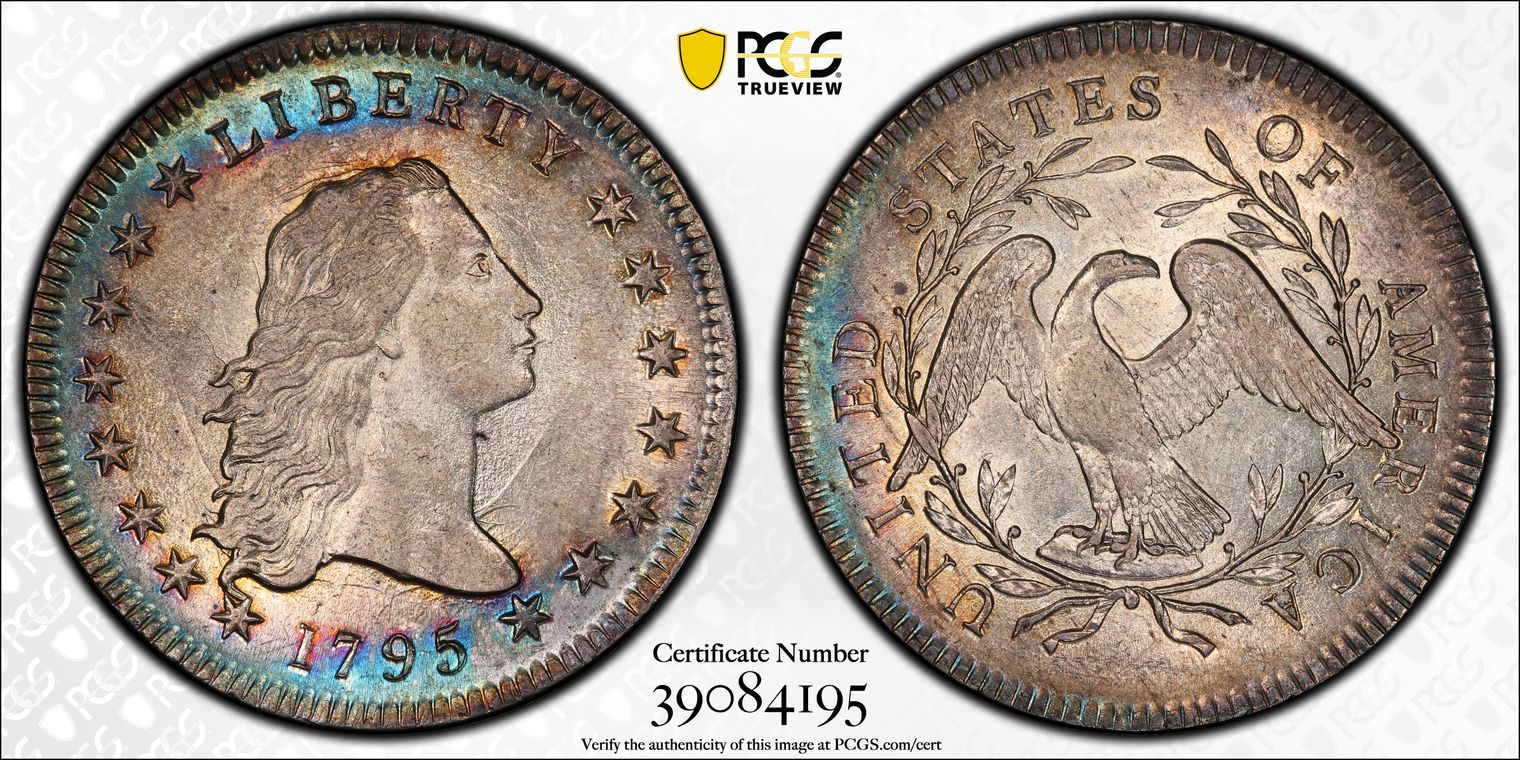1795 $1 Flowing Hair, BB-13 AU58+ 认证号39084195, PCGS号39980
拥有者评论
From the Cardinal Collection
专家评论
Q. David Bowers
The following narrative, with minor editing, is from my "Silver Dollars & Trade Dollars of the United States: A Complete Encyclopedia" (Wolfeboro, NH: Bowers and Merena Galleries, Inc., 1993). Note: the Notable Specimens list should be used with caution - it has been updated in my 2013 edition of "The Encyclopedia of United States Silver Dollars 1794-1804"Obverse die used to strike 1795 BB-11, BB-12, and BB-13.
REVERSE C: Two leaves under each wing. 17 berries, nine on left branch, eight on right. A berry is on outside of the wreath midway between S and T of STATES, the only variety in which this occurs; the arrangement is similar to that used on the 1794 dollar.
Reverse die used to strike 1795 BB-13 and BB-14.
DIE STATES:
Die State I: Perfect dies. Obverse without clash marks. The die state usually seen. Specimens are often seen with varying degrees of bifurcation on obverse and reverse, and somewhat indistinct denticles,
Die State II: Clash marks from the wings and the wreath are visible behind Liberty's head. Rare. Gilhousen (Superior, 1973): 1216, "almost VF," was described as from an "obverse die partly flattened and roughened by severe clash marks from reverse, parts of wings and wreath being very plain behind head."
Die State III: With "additional die cracks," as described in the 1945 catalogue of the F.C.C. Boyd Collection ("World's Greatest Collection").
AUCTION POPULATION SURVEY: Good: 1, Very Good: 6, Fine: 21, Very Fine: 13, Extremely Fine: 12, About Uncirculated: 1, Mint State-60 or better: 2 (considering Atwater coin, see below, as Mint State, per catalogue). Total: 56.
COLLECTING NOTES: I estimate that about 300 to 500 specimens exist of 1795 BB-13, a figure considerably more liberal than the Bolender suggestion of R-5 (31 to 75 coins, if he meant R-5 on the Sheldon Scale), or the 1881 Type-Table designation of "very rare."
NOTABLE SPECIMENS:
Rarcoa Specimen. MS-63. Rarcoa's Auction '90: 760.
"Choice Brilliant Uncirculated, boldly struck and superbly centered, displaying rather deep prooflike fields on both obverse and reverse-a possible Presentation specimen! Light adjustment marks are visible on the obverse .. "
Saunders Specimen. AU-55. Bowers and Merena, Ebenezer Milton Saunders Collection, 1987: 371, AU-55 (ANACS). "Gorgeous gray surfaces with color evenly distributed, highlighting one of the best strikes on a dollar of this date, every detail quite sharp."
Atwater Specimen. Net AU-50. (MS-60, planchet defect.) Laminated planchet. Atwater Collection, B. Max Mehl, 1946: 191. Ostheimer Collection, Lester Merkin, 1968: 231. "Brilliant Uncirculated, needle-sharp strike, full breast feathers, full curls, full claws; unheard-of impression, full frost; severe planchet defect on bust, long sliver-like lamination defect at N of UNITED." The March Sale (Stack's, 1985): 1227.
"Brilliant Uncirculated with full 'cartwheel' effect but has a number of natural defects caused at the mint before or during striking notably rough area at base of neck, a few minor areas as well at the first few stars, reverse displays elongated flake on the N of UNITED and some lighter spots near the eagle's head, surfaces are excellent."
DeCoppet Specimen. EF-45. James Kelly, 1955. "Choice EF, beautifully toned."
The March Sale Specimen. EF-45 .Stack's March Sale, 1983: 924. "Choice EF, sharply struck, with considerable frosty lustre, gives a cameo effect, russet and pale iridescent toning." 1975 ANA Convention Specimen. EF-40 .Superior, ANA Convention Sale, 1975:802. "EF-40, heavily toned gray and iridescent, well centered and struck, without harm except for one pin-prick right of the eagle's neck and one above Liberty."
Auction '88 Specimen. EF-40. Stack's, Auction '88, 1988: 1240. "EF, gray and russet toning over mint lustre, struck from heavily clashed dies, outlines of eagle, wreath, etc. clear on obverse around head."
Bauer Specimen. EF-40. Lester Merkin, 1968: 382. Ex Bauer Collection. "Advanced obverse clash marks. Basically EF, much mint lustre, weakly struck in centers. Obverse planchet defects as almost always. Very rare, one of two finest for die state."
Brown University Specimen. EF-40. Pine Tree, 1976: 307. "EF, gray tone, light and dark, central obverse sharper than usual, one minute rim nick and shallow edge dent on either side, fewer bagmarks than usual, light unobtrusive adjustment marks at obverse border."
Dunham Specimen. EF-40. Dunham Collection, B. Max Mehl, 1941: 1034 T.James Clarke Collection, New Netherlands 48th Sale, 1956: 613. "EF, hardly bold particularly upon reverse, beautifully mottled and toned, iridescent blue and pink, remarkable in spite of a very few microscopic defects."
Parsons Specimen. EF-40. Parsons Collection, H. Chapman, 1914 .M.H. Bolender Collection, Bolender, 1952: 10. "EF, even impressions, frosty surface around head."
Carter Specimen. EF-40 . The Amon Carter, Jr. Collection, Stack's, 1984: 211. "EF, iridescent toning mixed with pale golden toning."
Charlotte Specimen. EF-40. Stack's, Charlotte Collection, 1991: 1632, EF. "Roughly circular planchet lamination on cheek, neck and hair, (Undoubtedly a Mint-inserted silver plug.) hints of gold and violet toning, good deal of lustre on both sides."
December Sale Specimen. EF-40. Stack's, December Sale, 1987: 1519, EF, gray and russet toning over lustre, struck from heavily clashed dies, outlines of eagle, wreath, etc. clear on obverse around head, all details clear.
Shore Specimen. EF-40. Superior, Shore Collection, 1988: 2181. EF-40. Late die state with strong clash marks on the obverse. Original with dark gray surfaces highlighted by underlying suggestions of iridescence. Well centered and well struck on the obverse; eagle's left wing is weak. Extremely faint adjustment marks at 1:00 and 7:00 on obverse rim.
PCGS #
39980
设计师
Robert Scot
边缘
Lettered: HUNDRED CENTS ONE DOLLAR OR UNIT
直径
40.00 毫米
重量
27.00 克
铸币数量
16029
金属成分
90% Silver, 10% Copper
更高评级数量
0
评级较低的钱币数量
13
地区
The United States of America
价格指南
PCGS 数量报告
拍卖 - PCGS 评级的
拍卖 - NGC 评级的






















